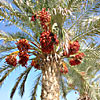Date Palm is a domesticated tree, but it grows wild near springs and in places where the groundwater is close to the surface – in the Arava, the Dead Sea Valley, and the lower Jordan Valley – because it requires warmth and water. The tree originates from the Middle East and Southwest Asia. It is a dioecious evergreen tree.
Its trunk is straight and reaches a height of 10-20 meters. The thickness of the trunk does not change during its entire lifetime. Its width is determined near the growing point.
The trunk is covered by the fibers of old leaves, and carries “palms” at its top, which are actually long leaves.
The leaves are pinnate, palms whose length reaches 2-3 meters. The leaf rachis carries green narrow and pointed leaflets on both sides. The leaflets are lanceolate, pointed at their tip. Every year the tree grows a new group of alternate leaves on the crown. However, they are so close to each other that they appear to be arranged in whorls.
The new and closed leaves serve as palm branches (lulav) for the commandment of the four kinds that is customary on Sukkoth. Upon the appearance of the new leaves, the old leaves are shed from the tree, while leaving their sheaths on the tree.
Blooming occurs in the months of April-May. The inflorescence is a panicle and the flowers are attached to the sheaths (branches) of the panicle. The fruit is a berry with a fleshy and sweet pulp. The date is harvested in August-December. As the branches of the panicle grow, the spathe opens and the large panicles become visible.
The flowers: have 6 tepals, the male flowers have 6 stamens, and the female flowers have a pistil made of 3 carpels (pollination is by wind).
In Hebrew, the word for harvesting dates is gadid.
Vegetarians and naturalists make sure to eat date products. The fruit is eaten fresh and preserved (dried) or in the form of date syrup which is used for eating and cooking. Dates contain a high percentage of potassium, iron and vitamin B.
Written by Udi Michlis








